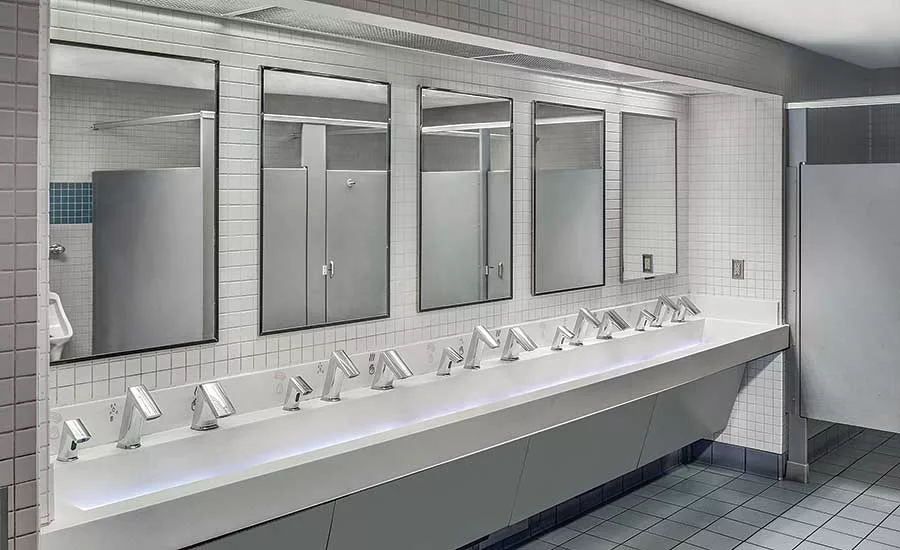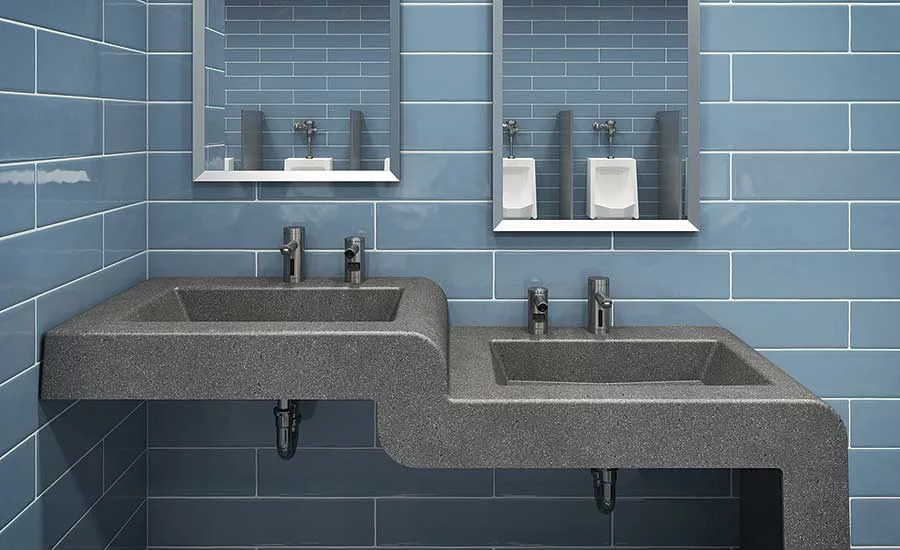Trends in commercial lavatories
A commercial restroom says a lot about the establishment it resides in.

The integrated sink systems at Los Angeles International Airport (LAX) are equipped with sink basins, faucets, soap dispensers and hand dryers to help decrease sanitation concerns. Photo credit: Sloan

Multi-level handwashing stations pair adult-height sinks with child-height fixtures for simultaneous use — an ideal solution for parents who need to provide handwashing assistance to their children. Photo credit: Sloan
A commercial restroom says a lot about the establishment it resides in.
The choice of sinks, faucets, soap dispensers and hand dryers can telegraph to the user that the establishment is high-end, professional, efficient, artistic, creative and friendly — or built tough for heavy-duty use and abuse.
Conversely, they can also signal that the establishment is old, worn out and poorly maintained — or that the owners just don’t care. The selection of sinks, faucets, soap dispensers and hand dryers is important to communicate to employees and visitors how much you care about them and how much you value your reputation.
The modern restroom
In the modern commercial restroom, sinks and faucets need to perform several key functions. Not only do they need to be rugged, reliable and resistant to heavy wear and tear, they also have to be elegant and deliver increased aesthetic value to the user’s commercial restroom experience. They have to be ADA (Americans with Disabilities Act)-compliant while meeting all applicable local, state and national regulations; be vandal-resistant when required in locations like schools, stadiums and concert halls; and save water.
Last but not least, they need to promote proper hygiene techniques and promote public health. Despite being the last step in the user’s commercial restroom experience, handwashing is certainly not least important.
Does selecting the right sink system sound like a tall order? Finding the ideal sink system certainly can be. Fortunately, there are some recent trends in sink design and functionality that make the process much easier. Use these new smart, modern and convenient characteristics to select the right lavatory for your facility and send the right message to your users.
All-in-one integrated sinks
Proper handwashing is a multi-step process. Water comes from the faucet, soap comes from a dispenser, paper towels come from another dispenser, and hand dryers are often across the room. The separation and inconsistent placement of all of these fixtures can lead to water splashed on the sink and floor, soap built up on sink decks and basins, paper towels littered throughout the restroom, and drips and splatter between the sinks and the dryers. Not only are these aesthetic and maintenance issues — wet, slippery floors are also a potential safety hazard.
The innovation of integrated sink systems is working to alleviate these problems. They are equipped with a sink basin, faucet, soap dispenser and hand dryer all at arm’s length, and they are also designed to work together as one touch-free, hygienic and highly efficient system. By moving soap dispensers and hand dryers to the deck, integrated sink systems are saving space and allowing for cleaner design.
Facilities of all types are beginning to adopt integrated sink systems. A high-traffic airport serving almost 75 million passengers annually, Los Angeles International Airport (LAX) specified integrated systems to decrease sanitation concerns. Meanwhile, Detroit’s iconic One Woodward office building installed integrated systems to give tenants an aesthetically superior experience while also getting them out of the restroom and back to their desks with an efficient handwashing process.
Promoting hygiene, reducing contamination
If lavatories have one goal above all others, it is to prevent the spread of germs.
The entire point of handwashing is to reduce the risk of exposure to disease-causing microorganisms. Since they are in some of the most heavily monitored facilities, we know that patients in health care facilities in the U.S. are contracting approximately 722,000 healthcare-acquired infections (HAIs) per year. Smart restroom designs — and lavatories, in particular — are doing their parts to cut down on these types of infections in health care facilities and beyond.
A key design goal of any sink is to get water down the drain with as little splashing as possible. Deep sinks with offset drains help to prevent contaminated water from splashing. By applying breakthrough “nano” coatings to vitreous lavatory fixtures, their hydrophobic (water-repellent) and oleophobic (oil-repellent) properties can not only repel liquids, but also inhibit the growth of germs and bacteria to keep fixtures cleaner for a longer period of time.
For faucets, it is imperative to promote handwashing in the cleanest possible environment. Touchless faucets minimize contact with surfaces where germs breed. Higher gooseneck spouts allow for handwashing up to the elbows when needed for health care or industrial applications where thorough and vigorous scrubbing is required.
Some automatic faucets include screens that guide the user and signal how to conduct a CDC (Centers for Disease Control and Prevention)-compliant hand washing. There are even automatic faucets with programmable flushes to ensure that drains are adequately rinsed to remove foul smelling liquids and soap build-up. The same programmable flushes can also be used to clear stagnant water from supply lines at regular intervals.
Delivering design flexibility
While promoting safe and effective handwashing techniques is paramount, there is also a demand for lavatories to provide an enhanced aesthetic value. Commercial restrooms are commonly the first destination a user will frequent in a facility, so providing an elegant experience with design options for all demographics is pivotal.
Manufacturers are now offering rounded front sinks for educational and healthcare facilities where children or patients might bump their heads, elbows and hips on what have typically been sharp corners. Multi-level handwashing stations are now available to pair adult-height sinks with child-height fixtures for simultaneous use — an ideal solution for parents who need to provide handwashing assistance to their children. Modern sinks can also include thoughtful features that the public will appreciate, such as purse hooks and touchless soap dispensers.
There are now more colors and finishes available than ever before. Architects and designers have the opportunity to implement their design vision in ways that could not have been possible just a few years ago.
It’s now possible to have integrated sink systems in elegant and expensive looking materials that stand up to commercial cleaning chemicals and heavy use.
Colors can match unique design elements, company colors or even sports team palettes. Special finishes like brushed nickel, brushed stainless or matte black on matching faucets, soap dispensers and hand dryers are exceptionally effective in signaling to the user they are in a high-end professional environment.
Some facilities are even bringing their brand to the bathroom by selecting faucets with custom faucet engraving. The Shedd Aquarium in Chicago now displays its logo on a select number of faucets in areas often used for private fund-raising events to add an increased level of visibility and recognition to its 87-year brand.
By making the above trends part of their commercial restroom criteria, architects, designers, owners and specifiers can simplify the selection process and maximize their aesthetic and public-health impact. Selecting integrated sinks can maximize user satisfaction while reducing potential maintenance issues and public safety risks.
Selecting automatic touchless faucets, soap dispensers and hand dryers reduces potential contamination and avoids additional wear and tear while simultaneously presenting an attractive and organized appearance. These can also have special programmable features like line flushes and operation modes to improve performance along with special finishes and customization to emphasize a VIP user experience.
Tell your manufacturer that you want these characteristics as your basis of design to save time and simplify your project from day one. You’ll be well on the way towards making your commercial restroom a memorable destination.
Looking for a reprint of this article?
From high-res PDFs to custom plaques, order your copy today!








